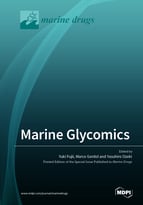Marine Glycomics
A special issue of Marine Drugs (ISSN 1660-3397).
Deadline for manuscript submissions: closed (18 February 2022) | Viewed by 33215
Special Issue Editors
Interests: glycobiology; apoptosis; biochemistry; marine biology; marine lectin
Special Issues, Collections and Topics in MDPI journals
Interests: antimicrobial peptides; bivalves; defense peptides; immunity; molecular evolution
Special Issues, Collections and Topics in MDPI journals
Interests: glycobiology; lectins; marine invertebrates
Special Issues, Collections and Topics in MDPI journals
Special Issue Information
Dear Colleague,
Marine creatures are rich sources of glycoconjugate-containing glycans and have diversified structures. The advance of genomics has provided a valuable clue for their production and developments. This information will encourage breeding and engineering functional polysaccharides with slime ingredients in algae. These glycans will have the potential for applications to antioxidant, anticancer, and antimicrobial drugs in addition to health supplements and cosmetics. The combination of both biochemical and transcriptome approaches of marine creatures will get the opportunity to discover new activities of proteins such as glycan-relating enzymes and lectins. These proteins will also be introduced to experimental and medical purposes, such as diagnostics and trial studies.
The topic of marine glycomics is also focusing on understanding the physiological properties of marine creatures, such as body defense against pathogens and cancers. In the competitions for natural selection, living creatures have evolved both their glycans and their recognition. They have primitive systems of immunity, and not few of their mechanisms are closely relating to glycans. If we are able to describe the accumulation of data of glycans of creatures living in the seashore and the oceans , we may be able to anticipate a time when we can talk about the ecosystem with glycans. That knowledge will be useful for the development of drugs that cure our diseases and for an understanding of living systems in addition to the preservation of living environments.
This Special Issue welcomes interdisciplinary articles and reviews relating to the wide topics of current glycoscience and glycoengineering.
For recent examples of Special Issue websites: https://www.mdpi.com/journal/marinedrugs/special_issues/marineglycobiology
Dr. Yuki Fujii
Dr. Marco Gerdol
Prof. Dr. Yasuhiro Ozeki
Guest Editors
Manuscript Submission Information
Manuscripts should be submitted online at www.mdpi.com by registering and logging in to this website. Once you are registered, click here to go to the submission form. Manuscripts can be submitted until the deadline. All submissions that pass pre-check are peer-reviewed. Accepted papers will be published continuously in the journal (as soon as accepted) and will be listed together on the special issue website. Research articles, review articles as well as short communications are invited. For planned papers, a title and short abstract (about 100 words) can be sent to the Editorial Office for announcement on this website.
Submitted manuscripts should not have been published previously, nor be under consideration for publication elsewhere (except conference proceedings papers). All manuscripts are thoroughly refereed through a single-blind peer-review process. A guide for authors and other relevant information for submission of manuscripts is available on the Instructions for Authors page. Marine Drugs is an international peer-reviewed open access monthly journal published by MDPI.
Please visit the Instructions for Authors page before submitting a manuscript. The Article Processing Charge (APC) for publication in this open access journal is 2900 CHF (Swiss Francs). Submitted papers should be well formatted and use good English. Authors may use MDPI's English editing service prior to publication or during author revisions.
Keywords
- cell signaling
- deep-sea
- glycomics
- infections
- lectins
- oligosaccharides
- origins of life
- polysaccharides
- structure of glycans
- transcriptome









